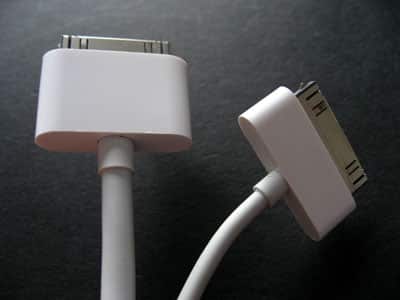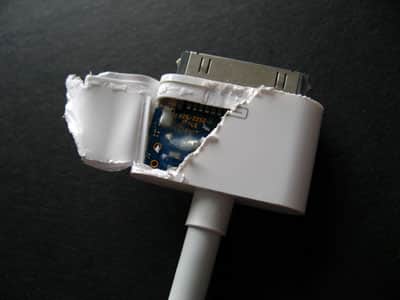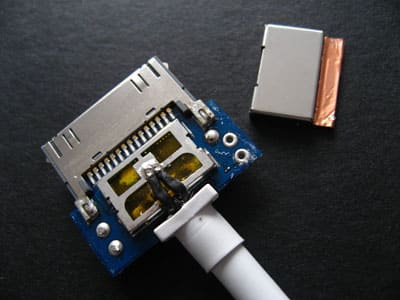When Apple released the iPhone in late June, some iPod users noticed that Apple had changed the packed-in USB-to-Dock Connector cable to something a little different and probably less expensive to manufacture. The classic Dock Connector cable had two small buttons on its sides, intended to help you disconnect your iPod from the cable. Apple’s new connector used a shell that was only half its predecessor’s height and had no buttons. It was seen in the earlier iPod Radio Remote, but not duplicated by third-party vendors, whose own connector casings were at least Apple’s size, if not bigger—a fact which made their accessories harder to use inside of some iPod cases.

The new USB cable started to show up in other Apple accessories and has now become the company’s “standard” Dock Connector. As it turned out, however, Apple still had a use for the bigger-style casings: it could squeeze chips inside, like the authentication chips required to unlock the video-out features of 2007 iPods.

Apple’s ability to miniaturize parts—or deal with companies that could do so—is now legendary. Could the company really find a way to squeeze a full circuit board and microcontroller set into the housing of an iPod Dock Connector cable? The answer was obviously “yes,” as current iPods can’t output video to TV without the authentication chip, but we wanted to see just how Apple had done it.

We grabbed an Apple Composite AV Cable ($49) and a knife, then introduced them. Kids, don’t try this at home. 
The knife helped to cut away a significant amount of plastic in the Dock Connector’s shell. We wound up using some small scissors to do additional trimming.

Ta-da! A circuit board. But besides an Apple part number, some wires, and some glue, there weren’t any chips there. So we flipped the board around to the other side.

Wow, what’s that? A metal box.
Actually, it’s a metal shield, most likely to reduce interference from whatever’s hidden underneath.

What’s underneath is a set of chips found inside a little butterfly-like metal and film enclosure. We had to pry the butterfly off of the board to get access to what was inside.

There’s the authentication chip. As it turns out, Apple’s now in its second stage of iPod accessory authentication: the 2.0a/b chipsets are the ones that are needed for unlocking video-out and other locked features of the 2007 iPods, and as previously noted, accessories without authentication chips won’t let new iPods output video. We’d heard some time ago that Apple is explaining the current chipsets to developers as a way to “guarantee that their accessories will be compatible” with iPods going forward, though no one is really sure what that means. It could mean that having the chip inside an accessory means that any new feature Apple may add won’t be locked to that accessory. It could also mean that Apple is going to break additional compatibility (say, audio-out) in next year’s iPods, like it did with video-out in this year’s, forcing people to buy accessories all over again.












